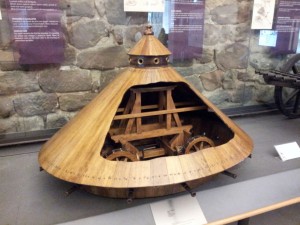In the last couple years of guiding, I’ve splashed out a bit from old routines. Years ago I used to relish trying new things on tour but in recent years I’d gotten a bit “sedentary”. So this year I decided to again try something new. I’d heard that tiny hill-top Vinci, birthplace of Leonardo, was a worthwhile stop, so I took a group there. It was, as advertised, a very worthy stop. As we climbed up the winding road we were rewarded with views of the northern Tuscan countryside - vineyards, olive groves, and wheat fields.

The ancient village of Vinci spills down a hillside, the top dominated by a tower and church. I walked my group into the empty courtyard beneath the tower to be rewarded with an impressive and large 3-D sculpture of Leonardo’s Vitruvian Man. It turns out the tower is half of the excellent little LdV museum (which should, in point of fact, be called the Leonardo and Bruneleschi Museum). Inside one finds small scale models of the many machines illustrated in LdV's various notebooks; a couple large-scale working models; rooms with hands-on displays of his experiments with locomotion, light, water, and propulsion; and a film about the creation of his various paintings.
But the highlight for me was a huge scale model of the crane designed by Brunelleschi to place the final stones into the lantern atop his magnificent dome in Florence. For years I’ve talked about Bruneleschi’s creativity - inventing the right machinery to solve engineering problems as needed. Here was an excellent visual, made even more meaningful by a computer- generated AV program showing how the crane was utilized.
The other half of the museum is nearly as impressive. It boasts several rooms with models and displays of more of LdV’s and Brunelleschi’s respective genius.
Here there are more AV programs demonstrating how the various machines were designed, constructed, and used. A couple hours spent in the museum with the helpful English translation cards and AV displays is the perfect complement to a visit to Florence and a guide’s explanation of the building of the dome or about LdV’s insatiable curiosity and creativity.
As a bonus, the town itself has that pre-commercial-tourism, unspoiled feeling. Prices are noticeably lower than tourist towns and people are friendly and unguarded. Lastly, there is a very nice replica of the famous equestrian statue LdV designed for the Duke of Sforza. For anyone with time and traveling by car I give Vinci two thumbs up. Its definitely worth a half day visit.




